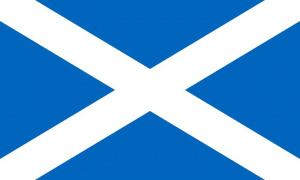Language/Scottish-gaelic/Culture/History-of-Scottish-Gaelic
| ◀️ Travel-Related Phrases — Previous Lesson | Next Lesson — Traditional Music and Dance ▶️ |
Origins of Scottish Gaelic[edit | edit source]
Scottish Gaelic is a Celtic language spoken in Scotland by around 60,000 people, mostly in the Highlands and Islands. The language is a member of the Goidelic branch of the Celtic languages, which also includes Irish and Manx. The Celtic languages are descended from the Celtic languages spoken by the ancient Celts, who lived in Europe from around 2000 BC.
The Scottish Gaelic language is believed to have developed from a form of Old Irish that was brought to Scotland by Irish settlers in the 5th century AD, during the time of the Dalriada Kingdom. This early form of Gaelic was heavily influenced by the native languages of the Picts and the Britons, as well as the Norse language spoken by the Vikings who raided the Scottish coast.
Over time, the different dialects of Scottish Gaelic began to merge into a single language, which became standardized in the 18th and 19th centuries, thanks in part to the efforts of Gaelic-speaking scholars and the publication of Gaelic literature.
Gaelic in Scotland's History[edit | edit source]
Scottish Gaelic played an important role in Scotland's history, particularly in the Highlands and Islands, where it was the dominant language until the 19th century. Many famous clans, such as the MacGregors, MacKenzies, and MacDonalds, were Gaelic-speaking, and many of Scotland's traditional Highland games and music are closely associated with the Gaelic culture.
However, the use of Gaelic declined significantly during the 19th and 20th centuries, as a result of government policies that sought to eradicate the language and culture. These policies included the banning of Gaelic in schools and the promotion of English as the language of education and commerce.
Despite this, the Gaelic language and culture have survived and even experienced a revival in recent years, thanks to the efforts of Gaelic-speaking activists and the recognition of Gaelic as an official language of Scotland in 2005.
Status of Gaelic Today[edit | edit source]
Gaelic is now recognized as an official language of Scotland, alongside English, and is taught in some schools and universities. However, the language is still considered endangered, as the number of fluent speakers continues to decline.
According to the 2011 census, there were just over 57,000 people in Scotland who spoke Gaelic, of whom only 32,000 were fluent speakers. This represents a decline of around 1,000 speakers since the previous census in 2001.
Efforts to revive the language include the establishment of Gaelic-language television and radio stations, such as BBC Alba, as well as the promotion of Gaelic-medium education and the provision of funding for Gaelic-language projects and community initiatives.
Interesting Facts[edit | edit source]
- The name "Gaelic" comes from the Gaelic word "Gaidhlig", which means "the language of the Gaels".
- Gaelic has a rich literary tradition, dating back to the 6th century, with famous poets such as Sorley MacLean, Iain Crichton Smith, and Aonghas MacNeacail.
- The Scottish Gaelic alphabet has 18 letters, and does not include the letters J, K, Q, V, W, X, Y or Z.
- The Scottish Parliament has Gaelic as an official language and has a committee dedicated to Gaelic issues. The Scottish Government also has a Gaelic Language Plan.
- The Scottish Gaelic medium school, Bun-sgoil Ghàidhlig Inbhir Nis, was established in Inverness in 2007, and was the first school to teach entirely in Scottish Gaelic since the 19th century.
- Gaelic is also spoken in Nova Scotia, Canada, where it is known as Nova Scotia Gaelic or Scottish Gaelic, and is spoken by around 2,000 people.
Other Lessons[edit | edit source]
| ◀️ Travel-Related Phrases — Previous Lesson | Next Lesson — Traditional Music and Dance ▶️ |

